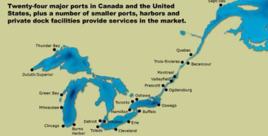Optimizing the Great Lakes: St. Lawrence Seaway Transportation System
An exploratory research on the key opportunities & barriers to container shipping on an underutilized waterway.
By Sjoerd Haazen, 2010
Abstract
 This report presents an analysis of the major opportunities and barriers to container shipping on the Great Lakes-St. Lawrence Seaway Transportation System in North America against the background of recent global economic developments, and is drawn up in conjunction with an economic analysis of the system’s potentials by Verboon (2012). Despite plenty of transit capacity and access to major North American markets not a single container moves beyond the Welland Canal to be discharged at American Great Lakes port today.
This report presents an analysis of the major opportunities and barriers to container shipping on the Great Lakes-St. Lawrence Seaway Transportation System in North America against the background of recent global economic developments, and is drawn up in conjunction with an economic analysis of the system’s potentials by Verboon (2012). Despite plenty of transit capacity and access to major North American markets not a single container moves beyond the Welland Canal to be discharged at American Great Lakes port today.
The opportunities identified encompass the fuel efficiency advantage of the marine mode over competing modes – in particular evaluated as an opportunity against the background of rising fuel prices, congestion relief on roads and railroads in and between the economic centers of the U.S. Midwest, the potential of the marine mode to reduce air pollution if a larger fraction of transportation needs is captured, and lower safety risks of marine mode activities compared to its surface transportation counterparts.
Interviews with stakeholders in the Great Lakes area have led to the identification of several key barriers to enhanced system performance. To begin with, services in the system cannot be provided on a year-round basis, primarily because of maintenance requirements. Additionally, an ad-valorem tax levied on goods imported into the U.S. through U.S. ports creates a cost disadvantage and a mental barrier to use of the marine mode, which is particularly relevant for the Great Lakes area given its proximity to Canadian ports and railroads where no tax is levied. Furthermore, U.S. and Canadian cabotage regulation limits competition for maritime transport services and flexibility of the system, which leads to higher prices paid by shippers and consumers. Pilotage requirements in the system drive up prices further because of costly pilotage activities. Although there are options to get an exemption, for cross-Atlantic trade it generally holds that the payments are made. Finally, perception of the Great Lakes as suitable for recreation activities rather commercial activities causes authorities, shippers, and the financial sector to be insufficiently aware of the system’s potentials.
Two sectors in the U.S. Midwest are identified as having the potential to reap the benefits from container movements on the Great Lakes in particular; the automotive sector and the chemicals sector. Both sectors are found to require transportation services for cargo volumes that are large enough for a new service to accommodate and are very well represented in the proximity of American Great Lakes ports. For these sectors, it holds that non-tariff barriers account for price increases that could be reduced significantly.
To gain insights into the likelihood of a new service being successful, previous container shipping initiatives on the Great Lakes have been evaluated which has led to the conclusion that the timing aspect of launching a new service and appropriate government support are crucial factors contributing to the success of new services. Compared to these initiatives, new service providers are advised to consider operations over longer distances and with larger ships to fully exploit economies of scale.
For the system to thrive a number of key system improvement opportunities are found. There seems to be significant potential for Canadian and American authorities to collaborate on efforts to improve the ease by which business can be done in the system. In this respect, evaluation of alternatives to current cost recovery practices of maintenance activities, integration of cabotage regulation, education of authorities and businesses domestically and overseas, and the implementation of intelligent technologies are key components of strategies that aim to explore the benefits of intensified use of the marine mode in the Great Lakes area.
Based on these findings policy makers are recommended to take a proactive role in the development of container shipping in the Great Lakes-St. Lawrence Seaway Transportation System. In particular, the current structure of the ad-valorem tax needs to be redefined, the legal frameworks between Canada and the U.S. need to be streamlined, and promotional efforts should be installed to make stakeholders familiar with the commercial potentials of the system.
A good start for the shipping industry would be to conduct a study in which potential cargo diversion as a result of the ad-valorem tax for the Great Lakes area specifically is researched. In addition, a North American common framework for cabotage regulation can be drawn up – perhaps based on the European Union model – and technologies can be installed to relieve the administrative burden to shipping in bi-national waters. Lastly, stakeholders can join forces to promote the system in the domestic setting as well as in Europe. Matching perception of the lakes with reality and transport needs with services available can provide the basis from which the Great Lakes-St. Lawrence Seaway Transportation System can contribute to the development of profitable and sustainable transport services.
Download
- <link fileadmin centre_content smart_port thesis_sjoerd_haazen_final.pdf>Download Sjoerd Haazen's Master Thesis

